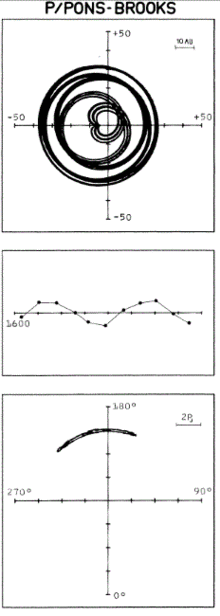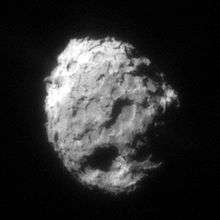12P/Pons–Brooks
| Discovery | |
|---|---|
| Discovered by |
Jean-Louis Pons William Robert Brooks |
| Discovery date | July 12, 1812 |
| Alternative designations | 1812; 1884 I; 1954 VII |
| Orbital characteristics A | |
| Epoch | 1954-Sep-15[1] |
| Aphelion | 33.468 AU |
| Perihelion | 0.77366 AU |
| Semi-major axis | 17.1212 AU |
| Eccentricity | 0.95481 |
| Orbital period | 70.85 yr |
| Inclination | 74.176° |
| Last perihelion |
May 22, 1954[2] January 25, 1884 September 15, 1812 c. March 10, 1668[note 1] |
| Next perihelion | April 21, 2024[2] |
12P/Pons–Brooks is a periodic comet with an orbital period of 71 years. It fits the classical definition of a Halley-type comet with (20 years < period < 200 years).[1] Its next closest approach to Earth is in 2024.[2]
As of December 2015 12P/Pons–Brooks has not been identified with any meteor-shower streams.[3]
Discovery
A comet was observed from Korea from 10 April to June 1313 CE.[4] Over in China, "in the reign of Jin Tsung, the 2nd year of the epoch Hwang King, 3rd moon, day Ting Wei, a comet appeared in the eastern part of S. D. Tsing". This date is calculated to 13 April 1313. The eastern part of the "S. D. Tsing" corresponds to the stars Mebsuta and Alhena in Gemini: about right-ascension 6h and declination 20°.[5] In Vietnam "during the third month (of the twenty-first year of the Hu'ng-long reign-period) (28 March to 25 April 1313) a hui comet was seen in the west".[6] Italian observers noticed a brilliant four-coloured apparition in the west, with two "horns" like the Moon.[7]
Koreans observed "another" comet over 20 March - 22 May 1668.[8] This one started from Pisces (~RA 1h, Dec. 30°) and traveled southwest across [western] Cetus toward Eridanus (~RA 5h, Dec. -10°). Again in Vietnam, "on a ky-su'u day of the first month, in the spring of the sixth year (of the Canh-tri reign-period), a mau-than year (8 March 1668) a 'Celestial Flail' star appeared in the northwest direction, measuring five feet and resembling a hui comet'";[9] this is further noted "in the Astronomical Chapters of the Ch'ing Shi Kao" in China.[10] A comet was also recorded beginning early March 1668 by Europeans; this appeared in the "Whale" constellation today known as Cetus and likewise traveled to Eridanus.[11][12]
No historical cometary observation has yet been securely identified with Pons-Brooks for its next perihelion circa 1740, although some would later wonder about the 1742 comet.[13] In the West a third observation was logged on July 12, 1812, by Jean-Louis Pons. Independently, this comet was later found by Vincent Wisniewski on August 1, and Alexis Bouvard on August 2 the same year. At the time no-one had brought these observations together.
In 1883 a (faint) "fourth" comet was accidentally discovered by William Robert Brooks and later identified as the same object as the 1812. Shortly after its initial discovery it was found to have an orbital period of about 70 years with an error of about 5 years. Johann Franz Encke determined a definitive orbit with a period of 70.68 years. This orbit was used to generate an ephemeris for the 1883-4 return, but searches were unsuccessful, until it was rediscovered by Brooks. This year it traveled from Scheat and Markab in western Pegasus, 13 January 1884; southward (through Pisces) to reach perihelion below Iota and Beta Ceti (~RA 0h, Dec. -10°) around 24 January.[14]
That February, Daniel Kirkwood tentatively identified Pons-Brooks with the comet of 1313; also with comet-sightings 1240, 1382, 1457, 1529[note 2] and 1742 (but could not link anything with the expected return 1670).[13] In 2007, Korean astronomers So-Yeon Park and Jongchul Chae confirmed Pons-Brooks with the observation of 1313, and added that of 1668.[16]
Orbit
Libration is locked at a 6:1 resonance with Jupiter.[17] The Tisserand invariant with respect to Jupiter (J) is 0.60.[18]

With a steep orbital inclination of 74.2° this comet does not spend a lot of time near the ecliptic. The Jet Propulsion Laboratory's (JPL) website shows that between the years 1900 and 2200, that the comet was and will be most significantly perturbed by Saturn on July 29, 1957. At that point it passed within 1.6AU of the giant planet's influence; even this approach had negligible effect.[20] The comet's orbit appears to be stable between 1740 and 2167, with no strong perturbations by any of the planets.[21][22]
Kirkwood in 1884 noticed that Pons-Brooks shares elements with De Vico's comet of 1846. He suggested that the latter had calved off Pons-Brooks some centuries prior.[13] Later he identified the two comets' capture into their elliptical orbits (or their parent body's capture) with their shared aphelion close to Neptune 991 CE.[23]
Speculations
Bonilla's comet
On August 12-13th of 1883, Mexican astronomer José Bonilla observed 447 bodies cross the solar disc, from an observatory in Zacatecas. Mexican astronomers in 2011 suggested that a comet may have split into several pieces. These objects were estimated to have had a size of between 46 and 1022 meters, and to have passed only 538 to 8062 km from the Earth. They raised Pons-Brooks as one possibility, in which case Earth barely avoided multiple Tunguska events or even a mass extinction.[24] This was reported in the media October 2011.[25][26][27]
But the source of these objects could also have been comet C/1883 D1 (Brooks-Swift) or even a third, unknown comet that year. The event also coincided with the annual Perseids meteor shower. Even migrating birds cannot be ruled out.[24]
Prehistorical times
Chinese historiography records its first comet around 1500 BCE, although long after the fact; traditionally, this "broom-star" heralded the sweeping-away of the tyrannical Xia dynasty (and its replacement with the Shang).[28] In Egypt, the so-called "Tulli Papyrus" (of dubious provenance) records a "disk of fire" for the third month of the 22nd year of Tuthmosis III (1486 BCE by one chronology). Freelance historical researcher Graham Phillips links these to Pons-Brooks and suggests it may have inspired the rise of a number of new religions around the world.[29]
This is however difficult to reconcile with Kirkwood's thesis of 1886, which if true means that the comet's orbit cannot be extrapolated (and was likely parabolic) prior to 991 CE.
Footnotes
References
- 1 2 "12P/Pons-Brooks". JPL Small-Body Database. Jet Propulsion Laboratory. SPK-ID: 1000068. Retrieved 2011-10-17.
- 1 2 3 12P/Pons-Brooks – Seiichi Yoshida @ aerith.net
- ↑ Dušan Tomko (1 December 2015). "Modeling of a theoretical stream of comet 12P/Pons-Brooks". Planetary and Space Science. 118: 35–37.
- ↑ So-Yeon Park; Jongchul Chae (2007). "Analysis of Korean Historical Comet Records". Publications of the Korean Astronomical Society. 22: 151–68., 163-4 #4.3.2, fig. 18.
- ↑ John Williams (1871). Observations of Comets from B. C. 611 to A. D. 1640: Extracted from the Chinese Annals. Translated, with introductory Remarks, and Appendix, comprising the Tables necessary for reducing Chinese Time to European reckoning and Chinese celestial Atlas. Strangways and Walden., 68 #284. This takes Yuan-era events from "the supplement to [Ma Twan Lin's encyclopaedia] and the She Ke".
- ↑ H Peng-Yoke (1964). "Natural Phenomena Recorded in the Đai-Viêt Su'-ky Toan-Thu', an Early Annamese Historical Source". Journal of the American Oriental Society: 127–149., 132 #19 from the Ban-Ky Toan-thu' ed. Ngo Si-Lien 1479, ch. 6.
- ↑ Albertin Mussatus of Padua in Ludovico Antonio Muratori, Rerum Italicarum scriptores (Milan: 1727), 598 book 3 rubric 6 "Prodigia". = page 14 in the 1636 edition. China and Italy noted George Frederick Chambers (1889). A Handbook of Descriptive and Practical Astronomy: The sun, planets, and comets (4 ed.). Oxford: Clarendon Press., p. 579 #415.
- ↑ So-Yeon Park and Jongchul Chae, fig. 17.
- ↑ H Peng-Yoke, 134 #44 from Ban-ky Thu'c-bien Truy-gia.
- ↑ Ibidem.
- ↑ P. Valentin Estancel (1674). "Observations Concerning the Comet That Was Seen in Brasil, An. 1668 in March". Phil. Trans. 9: 91–93.
- ↑ Lynn, W. T. (1882). "The Comet of 1668". The Observatory. 5: 329–331.
- 1 2 3 Daniel Kirkwood (February 1884). "The Comet of 1812 and 1883". Popular Science Monthly. 24: 488–91.
- ↑ William Dawson (1884). "The Pons-Brooks Comet". The Friend. 57: 194.
- ↑ Pierre Bayle (May 18, 2000). "56. Application to Comets of What Has Been Said Concerning Eclipses". Various Thoughts on the Occasion of a Comet. Translated by Robert C Bartlett. SUNY Press., 74
- ↑ So-Yeon Park and Jongchul Chae.
- ↑ A. Carusi; L. Kresak; E. Perozzi; G.B. Valsecchi (1987). "High-order librations of Halley-type comets". Astronomy and Astrophysics. 187: 899–905., 900.
- ↑ Ibidem, 899.
- ↑ A. Carusi, L. Kresak, E. Perozzi, G.B. Valsecchi. Fig. 5. Text, 902; graph, 903a
- ↑ "12P/Pons-Brooks close-approach data". JPL Small-Body Database. Jet Propulsion Laboratory. SPK-ID: 1000068. Retrieved 2009-05-06.
- ↑ Kronk, Gary W. (2001–2005). "12P/Pons-Brooks". Archived from the original on 2009-05-09. Retrieved 2009-05-07. (Cometography Home Page)
- ↑ A. Carusi, L. Kresak, E. Perozzi, G.B. Valsecchi, 905.
- ↑ Kirkwood (1886). "The Comets 1812 I, and 1846 IV". The Sidereal Messenger. 5: 13–14.
- 1 2 Manterola, Hector Javier Durand; de la Paz Ramos Lara, Maria; Cordero, Guadalupe (2011). "Interpretation of the observations made in 1883 in Zacatecas (Mexico): A fragmented Comet that nearly hits the Earth". arXiv:1110.2798
 .
. - ↑ "Billion-Ton Comet May Have Missed Earth by a Few Hundred Kilometers in 1883", MIT Technology Review (17 October 2011), https://www.technologyreview.com/s/425780/billion-ton-comet-may-have-missed-earth-by-a-few-hundred-kilometers-in-1883/
- ↑ "", The Week, http://theweek.com/articles/480924/did-massive-comet-almost-wipe-humans-1883
- ↑ John Stevens, "Revealed: The massive comet that came within a few hundred miles of hitting the earth in 1883 - with enough force to destroy mankind", Daily Mail (18 October 2011), http://www.dailymail.co.uk/sciencetech/article-2049896/Was-photographed-UFO-comet-nearly-hit-earth-1883.html
- ↑ Carl Sagan (1985). Comet. Michael Joseph. pp. 148–50.
- ↑ Phillips, Graham. "The End of Eden - Part 1". grahamphillips.net.
External links
- 12P/Pons-Brooks at the JPL Small-Body Database

- Comet 12P/Pons-Brooks light curve (Dmitry Chestnov)
| Numbered comets | ||
|---|---|---|
| Previous 11P/Tempel–Swift–LINEAR |
12P/Pons–Brooks | Next 13P/Olbers |

